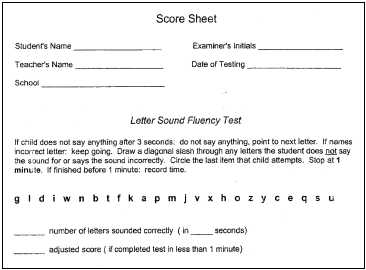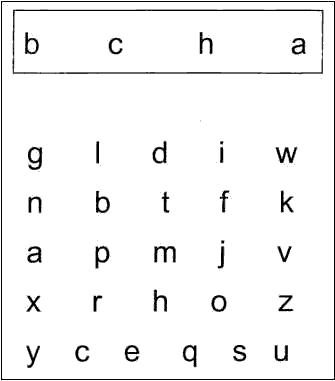How can teachers determine whether students are making appropriate progress?
Page 3: Select a Measure
 The first step in the progress monitoring process is to select a measure. GOM reading measures are used to assess key skills such as word identification and fluency. Often, the reading program selected by the school or district will include grade-level progress monitoring measures. In other instances, specific GOM measures might be chosen by school, district, or state administrators. This is typically the case when a school is using an MTSS or RTI framework for instruction. Educators can also decide independently to use GOM measures to monitor student progress and make instructional decisions. Regardless of who is making the choice, it’s important to keep several factors in mind when selecting a GOM measure:
The first step in the progress monitoring process is to select a measure. GOM reading measures are used to assess key skills such as word identification and fluency. Often, the reading program selected by the school or district will include grade-level progress monitoring measures. In other instances, specific GOM measures might be chosen by school, district, or state administrators. This is typically the case when a school is using an MTSS or RTI framework for instruction. Educators can also decide independently to use GOM measures to monitor student progress and make instructional decisions. Regardless of who is making the choice, it’s important to keep several factors in mind when selecting a GOM measure:
- Does it align with the grade-level reading skills?
- Is the measure reliable and valid?
- Does the measure have sufficient alternate versions?
- Is the measure relatively quick (e.g., one to eight minutes) and easy to administer?
- Is the measure designed to be administered to individual students or to groups? (Group-administered tests are often more convenient than individually administered ones.)
- Are versions of the test available in languages other than English?
With these considerations in mind, the educator should decide which reading measure is developmentally appropriate for the students. Below is a list of common measures, listed by grade level, for students who are developing at a typical rate in reading. These measures can be used to both assess a student’s current reading skills and to monitor a student’s reading growth across the academic year. Notice that as students’ reading skills progress across time, the reading measures below change accordingly.
The student is given a sheet of randomized letters and asked to say as many corresponding sounds as possible in one minute. This test must be administered to each child individually. Choose this assessment if you are interested in measuring students’ progress toward decoding.
Teacher: I’m going to show you some letters. You can tell me what sound the letters make. You may know the sound for some letters. For other letters, you may not know the sounds. If you don’t know the sound a letter makes, don’t worry. Okay? What’s most important is that you try your best. I’ll show you how this activity works. My turn first. (Refer to the practice portion of the CBM LSF sheet.) This says /b/. Your turn now. What sound does it say? Student: /b/ Examiner: Very good. You told me what sound the letter makes. You’re doing a really good job. Now it will be just your turn. Go as quickly and carefully as you can. Remember to tell me the sounds the letters make. Remember just try your best. If you don’t know the sounds it’s okay. Trigger the stopwatch.  |
 |
Source: Fuchs, Fuchs, & Powell (2004).
Letter Sound Fluency: The Teacher Score Sheet of the Letter Sound Fluency assessment provides script for the teacher to read to the student when administering the assessment. Underneath the teacher script is the actual score sheet with places to record the student’s name, teacher’s name, school, examiner’s initials, and date of testing. Also on the score sheet is the heading “Letter Sound Fluency Test” with shortened assessment directions. The letters of the alphabet of which the students will indicate the letter-sound are listed in a row for assessor notation. The final two lines of the score sheet include blanks for the number of letters sounded correctly and the time in which they were named, as well as the adjusted score if the test was completed in less than one minute. The student copy of the Letter Sound Fluency has four letters—b, c, h, and a—in a box for the practice portion of the assessment. Underneath the boxed letters are five rows of five letters each for which the student will indicate the letter-sound. The letters are not in alphabetic order.
The student is asked to read as many words as possible in one minute. Words are randomly selected from a list of the 500 most frequent sight words. This test must be administered to each child individually.
Teacher: When I say “Go,” I want you to read these words as quickly and correctly as you can. Start here (point to the first word) and go down the page (run your finger down the first column). If you don’t know a word, skip it and try the next word. Keep reading until I say “stop.” Do you have any questions? Trigger the stopwatch for 1 minute.
| Student’s Name _____________________ | Examiner’s Initials ________ |
| Student’s Teacher ____________________ | Date ____________ |
Score 1 for a correct response, 0 for an incorrect response.
| that | school | brought |
| for | say | line |
| by | land | probably |
| her | enough | close |
| up | live | table |
| them | against | strong |
| has | city | past |
| than | knew | friends |
| now | state | rest |
| water | wanted | having |
| must | four | full |
| me | toward | instead |
| come | move | case |
| still | power | worked |
| found | feel | alone |
| here | given | street |
| large | eat |
Source: Fuchs, Fuchs, & Powell (2004).
One of the most important CBM measures used with students in grades 1.5–6 is oral reading fluency (ORF), also known as passage reading fluency (PRF). In it, the student reads a passage for one minute. The passage’s difficulty is based on the student’s expected end-of-year reading competence. The score is the number of words she read correctly per minute. This test must be administered to each student individually.
Teacher: I want you to read this story to me. You’ll have one minute to read. When I say “begin,” start reading aloud at the top of the page. Do your best reading. If you have trouble with a word, I’ll tell it to you. Do you have any questions? Begin. Trigger the time for 1 minute.
| Summertime in the big city had always been hot, but this year it | 13 |
| seemed to be unbearable. The air was lifeless and the smells of the city | 27 |
| were multiplying until it began to remind Yolanda of one big dirty | 39 |
| clothes hamper. | 41 |
| Yolanda lived on the twelfth floor of a forty-story high-rise | 53 |
| apartment building, on the east side of the city near the river. The | 66 |
| apartment was too small for the five people in her family and much too | 80 |
| hot. Ma opened the windows in hopes of catching a breeze. Yolanda | 92 |
| and her sister Jackie offered to run to the store anytime Ma needed | 105 |
| something just so they could stand in a place that had air conditioning. | 118 |
| Yolanda was thirteen years old; too old to play on the kiddie | 130 |
| playground and too young to get a summer job. She spent most of the | 144 |
| time sitting on the front steps of the apartment building watching the | 156 |
| traffic go by. She and her friends sometimes played hopscotch. | 166 |
| One morning as Yolanda was watching TV she saw a | 176 |
| commercial that gave her an idea. It was a lemonade commercial. It | 188 |
| advertised that lemonade was cool and refreshing, just the drink to | 199 |
| quench a summer thirst. | 203 |
| Yolanda ran down to the corner store to buy some lemonade | 214 |
| supplies. She bought a package of paper cups for two dollars and two | 227 |
| pounds of lemons for 60 cents a pound. She also got a small bag of | 241 |
| sugar in case the lemons were too sour. She wanted to make the best | 255 |
| lemonade ever sold on East Street. | 261 |
| Yolanda made two gallons of lemonade, added two teaspoons of | 271 |
| sugar for taste, gathered the cups and ice, and went downstairs to set up | 285 |
| her lemonade stand. She set it up in front of the building and sold four | 300 |
| glasses in fifteen minutes. She charged 10 cents per cup so she had | 312 |
| only made 40 cents. | 315 |
| Then Yolanda’s friend Clare came by and offered to make signs | 326 |
| advertising Yolanda’s business. Clare took the signs and placed them | 336 |
| near the street. Around 5 o’clock a big traffic jam had stopped traffic | 348 |
| on East Street. Drivers were hot and angry, and Clare carried cups of | 361 |
| lemonade to them to calm them down. Some were so grateful that they | 374 |
| tossed dollars out of their windows. | 380 |
| By the end of the day, the two young businesswomen had made | 392 |
| $30. Yolanda split the profits with Clare, and they agreed to open the | 404 |
| stand at ten o’clock the next morning. | 411 |
| “I’ll bet we can make $50 tomorrow if we have another traffic | 422 |
| jam!” called Yolanda to Clare with a smile. | |
| Total Score | _____ |
Students read silently for a specified amount of time (e.g., one minute, three minutes). Every seventh word in the text has been deleted and three possible choices offered. The student circles the word that best fits the meaning of the phrase or sentence in the passage. The student’s score is the number of correct replacements she makes. Because students read silently, this measure can be administered in a group setting.
Stuart had nice parents. They did not embarrass him in [glad/ front/ yellow] of his friends. His father did
[not/ ant/ soft] yell at him during his baseball [center/ games/ lines], and his mother never kissed him
[in/ tot/ put] front of his friends. He generally [liked/ flow/ jeep] his parents, except for the fact
[show/ went/ that] they were sending him to summer [bus/ dump/ camp] this year.
Stuart did not want [to/ wit/ cow] go to summer camp. The thought [and/ be/ of] it made him picture
himself hot [coat/ rest/ and] thirsty, hiking up a dusty trail. [Bit/ He/ Go] knew that summer camp food had
[of/ to/ my] be bad news, too. Besides, summer [camp/ free/ dog] was for people with nothing else
[fad/ to/ sew] do. He had plenty of things planned [for/ much/ very] his summer at home.
“Summer camp [will/ yes/ belt] be good for you,” said Mother. “[Feel/ And/ Lot] I don’t want to hear
another [catch/ phone/ word] about it!” Stuart moped around the [beat/ opens/ house] until it was time
to go. Mother [had/ with/ boy] packed his trunk full of clothes, [and/ sort/ time] she and Dad took Stuart
to [real/ glob/ the] bus station. Stuart tried hard not [to/ sun/ we] cry when he hugged them goodbye.
[Yet/ He/ Sat] ran onto the bus and buried [beam/ his/ neat] head in his hands. After a [while/ tall/ hate],
he looked out the window.
Source: Fuchs, Fuchs, & Powell (2004).
Research Shows
Research on the effectiveness of CBM has been ongoing for more than 40 years. Below are just a few of the findings related to the effectiveness of progress monitoring reading measures.
- A review of the literature on CBM reading measures verified the relationship between passage reading measures and reading comprehension.
(Wayman et al., 2007) - Secondary students’ scores on CBM maze measures are reliable and valid indicators of their reading level and progress.
(Chung et al., 2018)xmaze
glossary
- Student performance on oral reading and maze measures was strongly correlated with their performance on end-of-year standardized reading comprehension tests.
(Shin & McMaster, 2019) - Researchers used both oral reading and maze measures with English learners (ELs) and non-ELs to predict their performance on the reading portion of a state standards test for third- and fifth-grade students. Moderate to moderately strong correlations were obtained between the state standards test and both reading fluency and the maze task.
(Wiley & Deno, 2005)
For Your Information
A variety of GOM measures are commercially available in reading. These standardized measures typically include the tests, administration procedures, and scoring guides that have been developed to produce reliable and valid scores. Additionally, student benchmarks and the expected rate of improvement (ROI) are often provided by the developer.
standardized measure
glossary
 The National Center on Intensive Intervention (NCII) provides a tools chart that presents information about commercially available progress monitoring probes that have been reviewed by a panel of experts and rated on key features.
The National Center on Intensive Intervention (NCII) provides a tools chart that presents information about commercially available progress monitoring probes that have been reviewed by a panel of experts and rated on key features.
Grade-level GOM measures are appropriate for typically achieving students as well as for many who are struggling. However, these measures might not be appropriate for students who are consistently not performing at grade level. These students might require a measure designed for a different grade level. Sometimes, commercially available measures include directions on selecting an appropriate grade-level probe for these students. If they do not, the educator should:
Example
Amelia is a fourth-grade student, but her current instructional level in reading is third grade. However, her teacher administers fourth-grade ORF probes because she expects Amelia to perform at this level by the end of the year:
- The teacher administers three fourth-grade ORF probes.
- Amelia’s median score on the three probes is 25.
- The teacher continues to administer fourth-grade probes for the year. Note: This will be Amelia’s goal level for progress monitoring. Even though Amelia started the year at a third-grade instructional level, the teacher expects to be using fourth-grade instructional materials later in the year.
-
- Administer three ORF probes at the grade level the student is expected to perform at by the end of the year (i.e., the student’s long-term goal). Note: This may not be the student’s current grade level.
- Identify the student’s median score for the three passages. Use the chart below to select the appropriate grade-level probe. As indicated in the table, the educator might need to administer additional probes at higher and lower levels until the correct grade-level probe is identified.
median
glossary
| Words Correct in One Minute | Rules for Selecting an Appropriate-Level Measure |
| <10 | Use word identification fluency. |
| 10-50 | Continue to use this grade level. If the student is making a lot of errors, consider moving down one grade level. |
| >50 | Move up one grade level, but not higher than the student’s grade level. |
- Monitor the student’s progress using probes at the determined goal level throughout the entire school year.